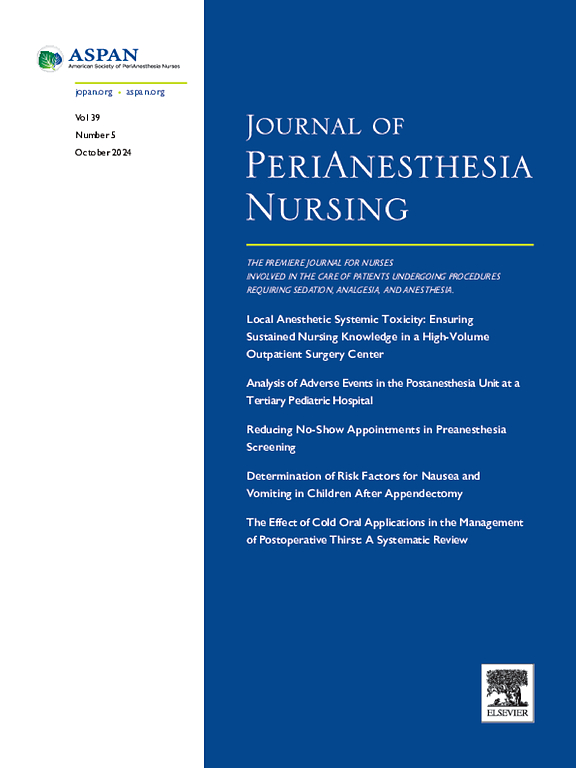使用 Exspiron 分钟通气监测缩短阻塞性睡眠呼吸暂停和肥胖患者手术后在麻醉后护理病房的住院时间。
IF 1.6
4区 医学
Q2 NURSING
引用次数: 0
摘要
目的:在麻醉后护理病房(PACU),必须对呼吸和通气进行监测,尤其是对确诊患有阻塞性睡眠呼吸暂停(OSA)或有此风险的患者。已发表的研究强调了分钟通气监测(MVM)作为即将发生呼吸衰竭的早期预警系统的重要性,因此有必要进行研究,以评估加州大学圣地亚哥分校医疗中心的这一高风险人群能否及时安全出院:本定量研究采用两组比较设计法:对 100 名确诊或疑似 OSA 或有记录的体重指数≥40 的手术高危患者在使用和未使用 MVM 的情况下的住院时间进行测量,以评估 MVM 对 PACU 住院时间的影响。对 50 名患者使用加州大学圣地亚哥分校(USCD)健康标准护理监测呼吸频率、脉搏血氧饱和度,并在必要时使用卡式通气造影进行监测,然后与 50 名使用加州大学圣地亚哥分校健康标准护理监测并使用 Exspiron 监测设备添加 MVM 的患者进行比较:接受 MVM 的患者(M = 106.22,SD = 56.85)的 PACU 住院时间比未接受 MVM 的患者(M = 140.96,SD = 81.55)缩短了 34.74(95% CI,6.64 至 62.83),t(97) = 2.46,P = .016,差异有统计学意义。两组患者共节省了 1843 分钟的 PACU 病床占用时间:结论:在手术后患者的标准护理之外使用分钟通气监测可显著缩短已知或疑似 OSA 高危患者安全离开术后护理病房的时间。本文章由计算机程序翻译,如有差异,请以英文原文为准。
Decreasing Postsurgical Length of Stay in the Postanesthesia Care Unit for Obstructive Sleep Apnea and Obese Patients Using Exspiron Minute Ventilation Monitoring
Purpose
In the postanesthesia care unit (PACU), it is imperative to monitor respiration and ventilation, especially in patients diagnosed with or at risk for obstructive sleep apnea (OSA). Research studies have been published to highlight the importance of minute ventilation monitoring (MVM) as an early warning system of impending respiratory compromise, warranting studies to assess timely safe discharge in this high-risk population at UC San Diego Health.
Design
This quantitative study was conducted using a two-group comparative design method.
Methods
Length of stay was measured in 100 patients identified as high risk in the surgical setting with diagnosed or suspected OSA or a documented body mass index ≥40 with and without the use of MVM to evaluate its impact on PACU length of stay. Fifty patients were monitored using the University of California San Diego (USCD) Health standard of care monitoring of respiratory rate, pulse oximetry, and capnography when indicated, then compared to 50 patients monitored with the UCSD Health standard of care with the addition of MVM using the Exspiron monitoring device.
Findings
PACU length of stay decreased for those who received MVM (M = 106.22, SD = 56.85) than those who did not (M = 140.96, SD = 81.55), a statistically significant difference of 34.74 (95% CI, 6.64 to 62.83), t(97) = 2.46, P = .016. Total time savings between the 2 groups was 1,843 minutes of PACU bed occupancy.
Conclusions
The use of minute ventilation monitoring in addition to the standard of care in postsurgical patients can significantly reduce the length of high-risk patients with known or suspected OSA safely from the postoperative care unit.
求助全文
通过发布文献求助,成功后即可免费获取论文全文。
去求助
来源期刊

Journal of Perianesthesia Nursing
NURSING-
CiteScore
2.20
自引率
17.60%
发文量
279
审稿时长
90 days
期刊介绍:
The Journal of PeriAnesthesia Nursing provides original, peer-reviewed research for a primary audience that includes nurses in perianesthesia settings, including ambulatory surgery, preadmission testing, postanesthesia care (Phases I and II), extended observation, and pain management. The Journal provides a forum for sharing professional knowledge and experience relating to management, ethics, legislation, research, and other aspects of perianesthesia nursing.
 求助内容:
求助内容: 应助结果提醒方式:
应助结果提醒方式:


